
History Tidbit: Lebanese Immigration to Mexico
First Immigrants and the Ottoman Empire – In the 19th century, Lebanon was part of the Ottoman Empire, and the ratio of Christians to Muslims was in decline, becoming a minority by the 1860s; this brought social and political pressure on Christian families, prompting many to flee the region. Hence, there was an almost spontaneous increase of refugee flow out of the region; the first documented arrivals of Lebanese immigrants to Mexico date to the late 1870s to the 1890s; travelling in French ships from Beirut to the Gulf of Mexico, these immigrants arrived to Mexican ports such as Veracruz (in the state of Veracruz) and Tampico (in Tamaulipas), as well as the Yucatan peninsula.
The Yucatan Peninsula and The Henequén Trade – At the end of the 19th century, Cuba was fighting for its independence from Spain; the USA was rising as a power in the Americas, and president William McKinley faced mountainous pressure to enter the war after an American ship mysteriously exploded in the Havana Harbour. The Spanish–American War only lasted a few months (April 21 – August 13, 1898), ending with The US acquiring ownership of Puerto Rico, Guam, and the Philippine islands. Although the war was short-lived, these Spanish colonies suffered greatly; one effect was a global shortage of Manila hemp fibre supplies from the Philippine Islands. In Mexico, these events brought a felicitous turn and great wealth to the Yucatan peninsula, the main producer of henequén, a type of fibre that promptly filled the lost markets of the Manila hemp. By the turn of the century, Yucatan was a rapidly developing region, attracting trade and immigration from Europe, Asia, and the Middle East. Many Lebanese families settled in Yucatan, where they were known as Turks (since their passports were still Ottoman.)
Modern Times – During World War I (1914-1918), the Ottoman Empire was an ally of Germany, causing immigration out of the Lebanon region to increase; after the war ended, the Empire was dissolved and Lebanon became a protectorate of France in 1920. These and other political events, and war all throughout the 20th century, have also caused periods of higher immigration rates from Lebanon to Mexico. As of the 1930s, Lebanese families also started to settle in central Mexico, mostly in Puebla, and Mexico City.
As a consequence, over the decades, some Lebanese/Middle Eastern preparations have been adopted and adapted to regional Mexican cuisines. For example, I have mentioned how the vertical rotating grill and the shawarma/doner kebap were brought to the Mexican state of Puebla, evolving into the “taco árabe” (Arabian taco), and ultimately inspiring Mexico City’s iconic taco al pastor (shepherd’s style taco).
Another example is Kibbeh, considered the national dish of Lebanon; it consists of a mixture of ground meat with bulgur wheat, as well as seasonings such as onion and spearmint. There is a variety of fillings, toppings, shapes, and cooking methods (even served raw), but the most popular outside the Middle East are the fried croquettes that look like small American footballs, stuffed with a ground lamb filling. Lebanese families in the Yucatan peninsula introduced these patties, which became part of the regional cuisine, known as Kibis (pronounced “key-bees”). Lamb meat was altogether substituted by pork, beef, or a mixture, and currently, many recipes have other fillings, or are open lengthwise and stuffed after frying. In addition, some local ingredients were added, such as tomatoes, and the classic topping for kibis is a spicy cabbage dressing.
Another iconic foodstuff that arrived to the Yucatan peninsula because of the prosperous henequén trade was Edam cheese, which is known as queso holandés (cheese from Holland), or queso de bola (cheese ball). Dutch merchants arrived to Yucatan, interested in the henequén fibre for ropes and twine, but brought with them food from their land; the bright red-waxed balls were suitable for long trips, and were first distributed in the black market, eventually becoming an integral part of merchandise at the region’s duty free ports, such as Chetumal, in the state of Quintana Roo. Locals fell in love with the cheese, creating dishes such as queso relleno (a hollowed Edam cheese stuffed with a ground meat dressing), marquesitas (wafer-like pastries filled with Edam cheese), and … as a filling for kibis!
And so, that is the story of kibis con queso de bola, a tasty allegory of the amalgamation of Lebanese, Dutch and Mexican history, from an emblematic Lebanese dish and a classic Dutch cheese, both introduced by foreigners attracted to the Yucatan peninsula by the henequén trade.
For this recipe, I would normally use ground beef, but since my vegetarian daughter is home this week, I used a plant-based ground product:

I started with a 1:1 by weight proportion of meat to dry bulgur wheat, as most recipes call for, but after re-hydrating the bulgur, its volume seemed too much for the amount of meat, especially since these kibis have cheese instead of a meaty filling, so I reduced the amount closer to a 2:1 by weight ratio of meat/dry bulgur wheat. For the filling, I could not find Edam cheese (easier to find in Yucatan!) so I substituted with Gouda, milder and softer, but widely available, and as a bonus, also a little more affordable than Edam.
In the Yucatan peninsula, sour orange juice is the staple for sauces and dressings, but are hard to find, even in the rest of Mexico; as I have mentioned before, a mix of other citrus juices and/or vinegar will do in a pinch. For the cabbage topping in this recipe, I chose lime and regular orange juices. Finally, Habanero peppers are called for, as well, but Scotch Bonnet peppers may be used if Habaneros are not available, and the amount reduced or increased, to personal tolerance; as always, I recommend wearing food-grade gloves to handle very spicy peppers, or using a fork to avoid contact with the skin.
Ground Meat and Wheat Patties with Cheese – Kibis con queso de bola
Printable recipe: Ground Meat and Wheat Patties with Cheese – Kibis con queso de bola
Ingredients (for 18 pieces)
Patties:
¾ lb (340 g) ground meat (beef, pork, a mix, or plant-based substitute)
1/3 lb (150 g) dry bulgur wheat
9 oz (255 g) Edam (or Gouda) cheese; wax removed, and cut up into ½ oz (14 g) blocks
1 large tomato; washed, stem spot removed, and quartered
¼ white onion; peeled
¼ cup fresh spearmint leaves; washed
1 tsp salt, or to taste
1 tsp ground white pepper, or to taste
Oil for deep frying
Topping:
1 small cabbage; tough bottom removed, shredded, washed, and drained (approx. 6 cups)
1 red onion; peeled, and sliced thinly
2-3 Habanero (or Scotch Bonnet) peppers, or to taste; washed, stems and seeds removed, sliced thinly
¾ cup sour orange juice (or mix equal parts of orange juice and lime juice)
1 ½ tsp salt, or to taste
Place dry bulgur wheat in a large bowl (photo below, left). Add enough cold water to cover (photo below centre). Allow to soak for two to four hours, adding more water, as needed. Drain water by pouring into a colander, and pressing hydrated grains down with the back of a spoon (photo below, right):

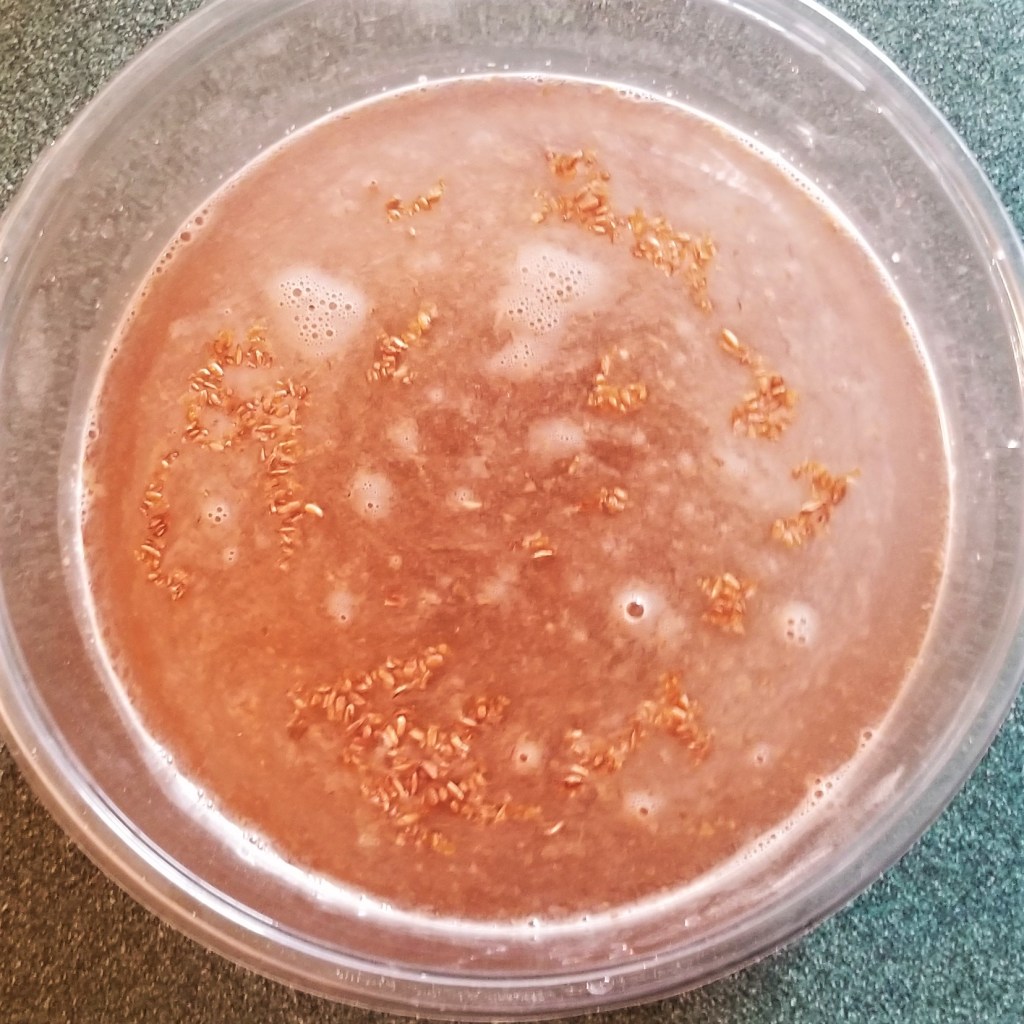
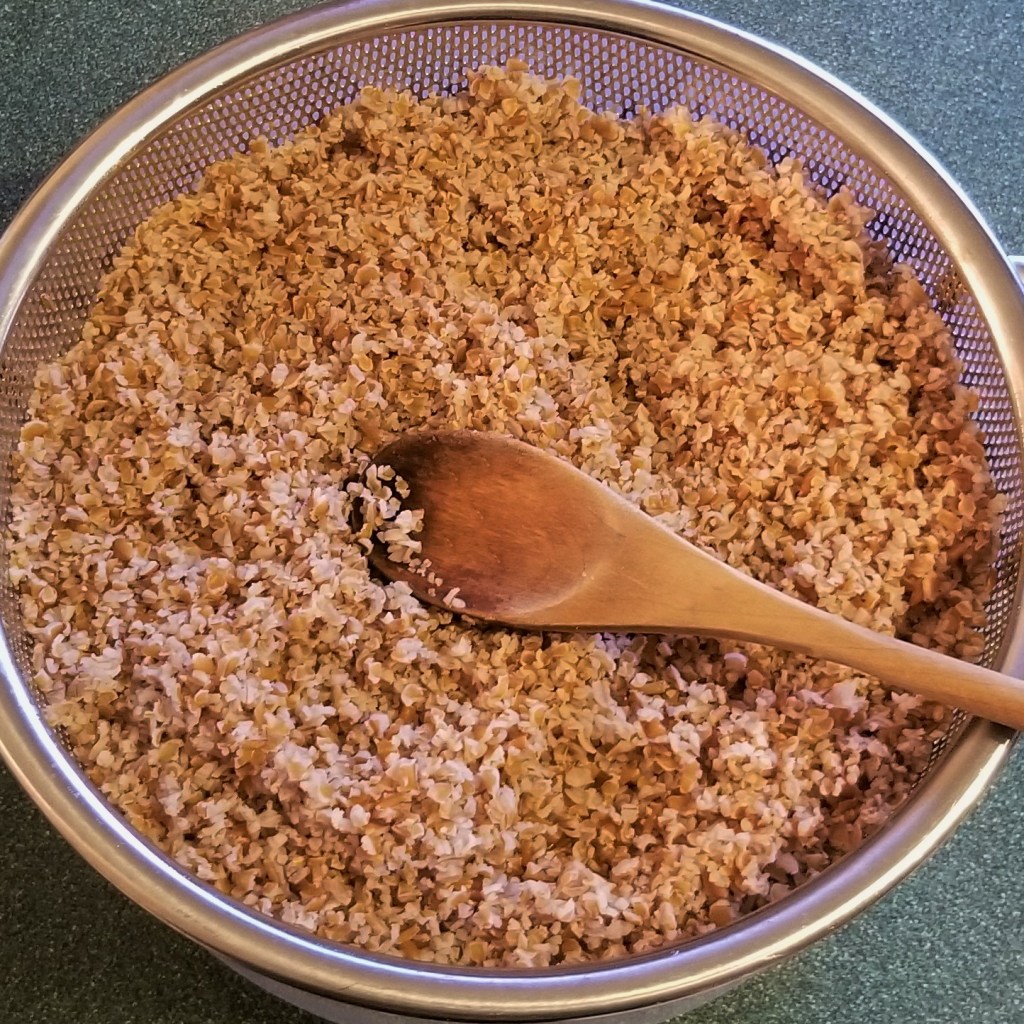
Reserve.
While the wheat is soaking, prepare the topping by mixing cabbage, red onions, hot peppers, citrus juice, and salt, in a non reactive container:

Cover and reserve in the fridge until serving time.
Once bulgur wheat is ready, place tomatoes, white onion and spearmint leaves in a blender jar (photo below, left). Process until smooth (photo below, right):
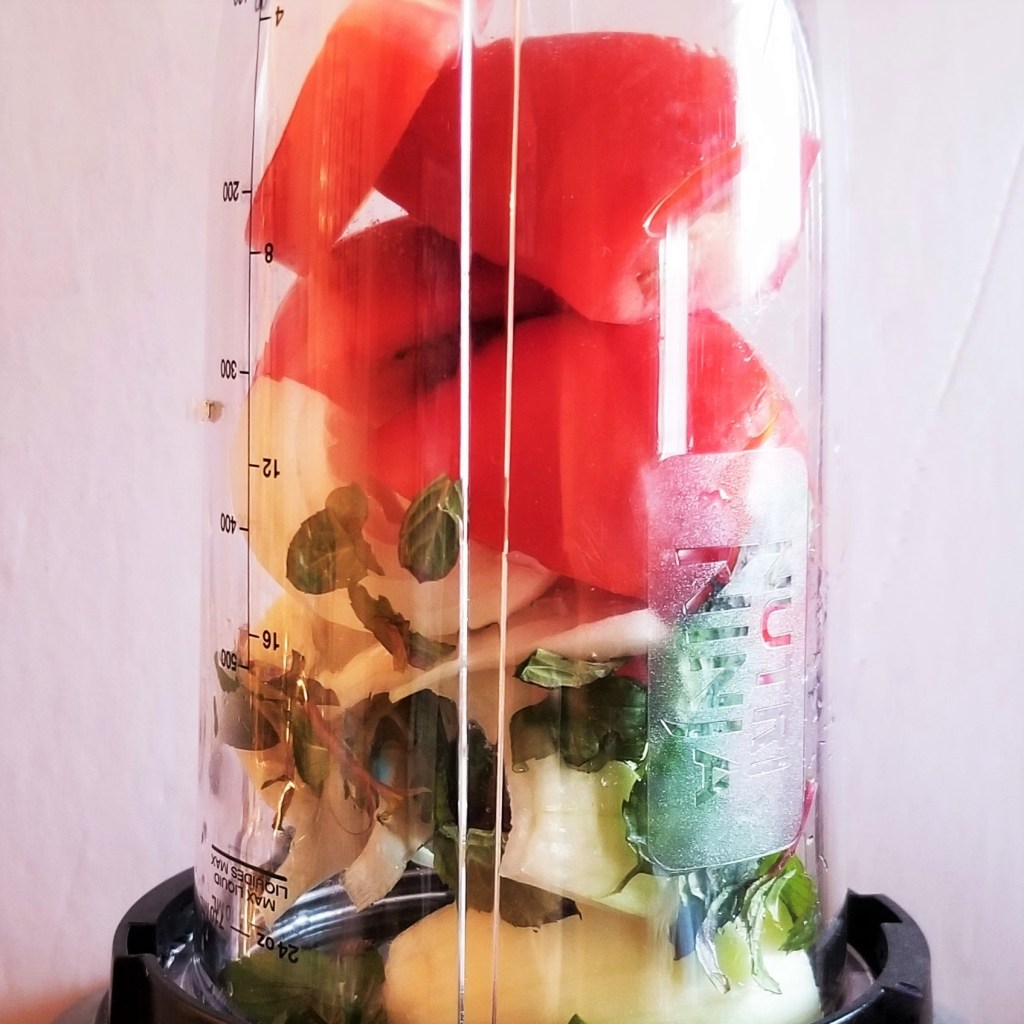
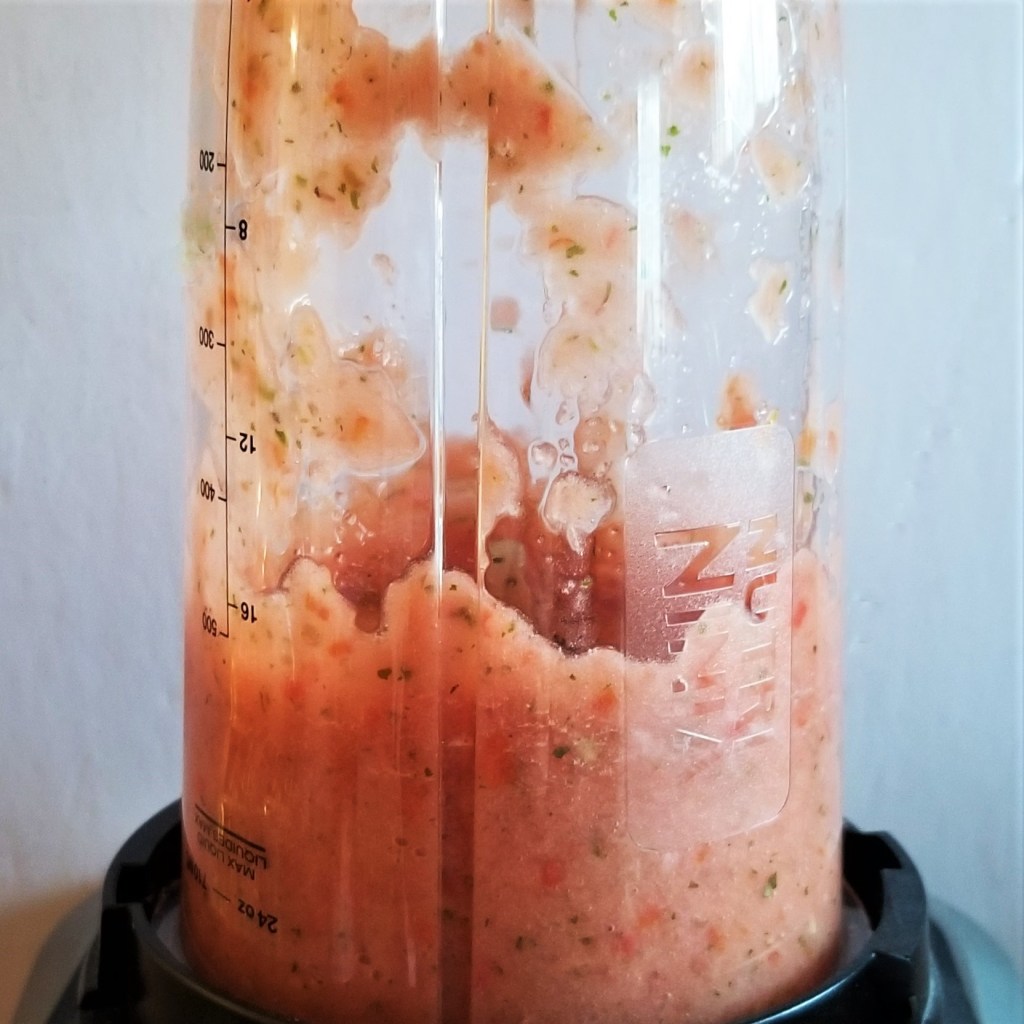
Transfer drained wheat to a large mixing bowl, then mix in ground meat, salt, pepper, and tomato sauce (photo below, left). Continue mixing with clean hands, until a uniform paste is formed (photo below, right):
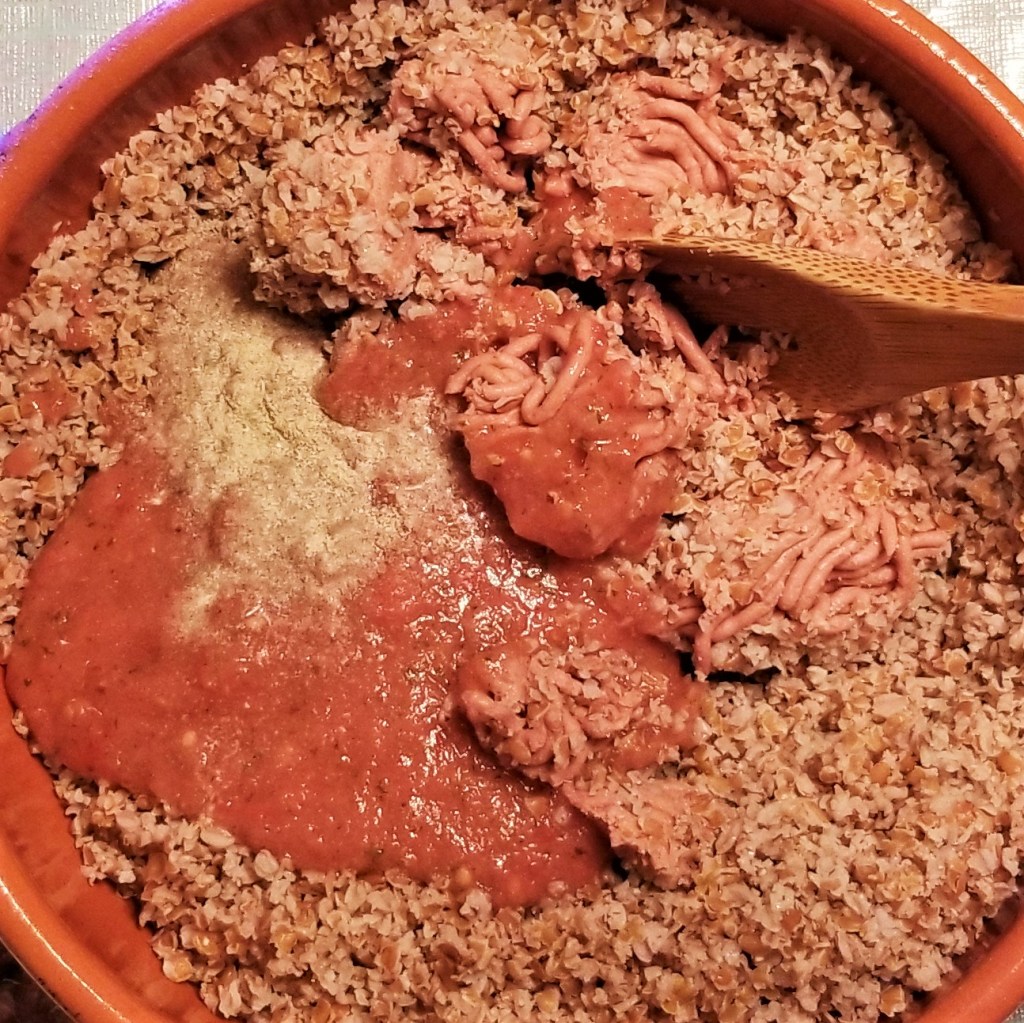
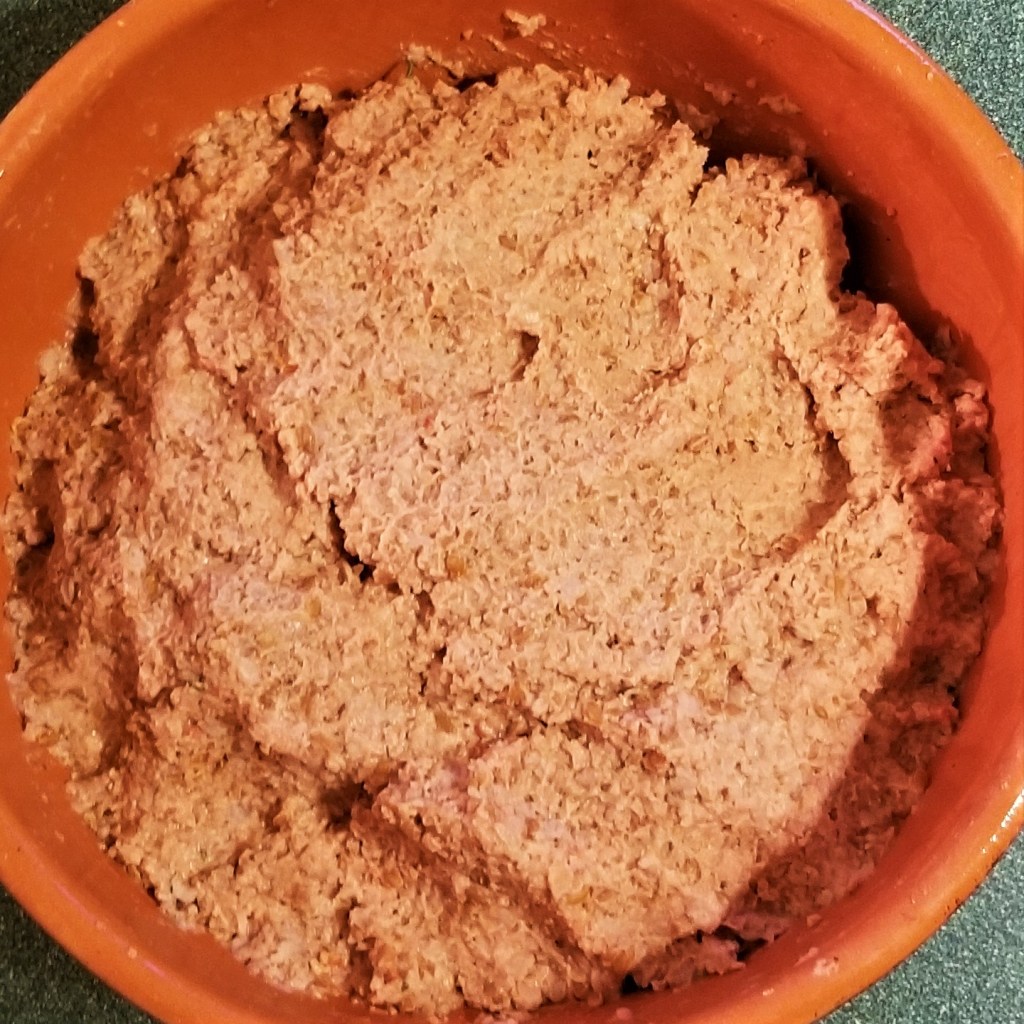
To form the patties, measure a quarter of a cup of paste, and form into a ball (photo below, left). Using a thumb or the handle of a wooden spoon, press the centre of the ball to make a well (photo below, right)
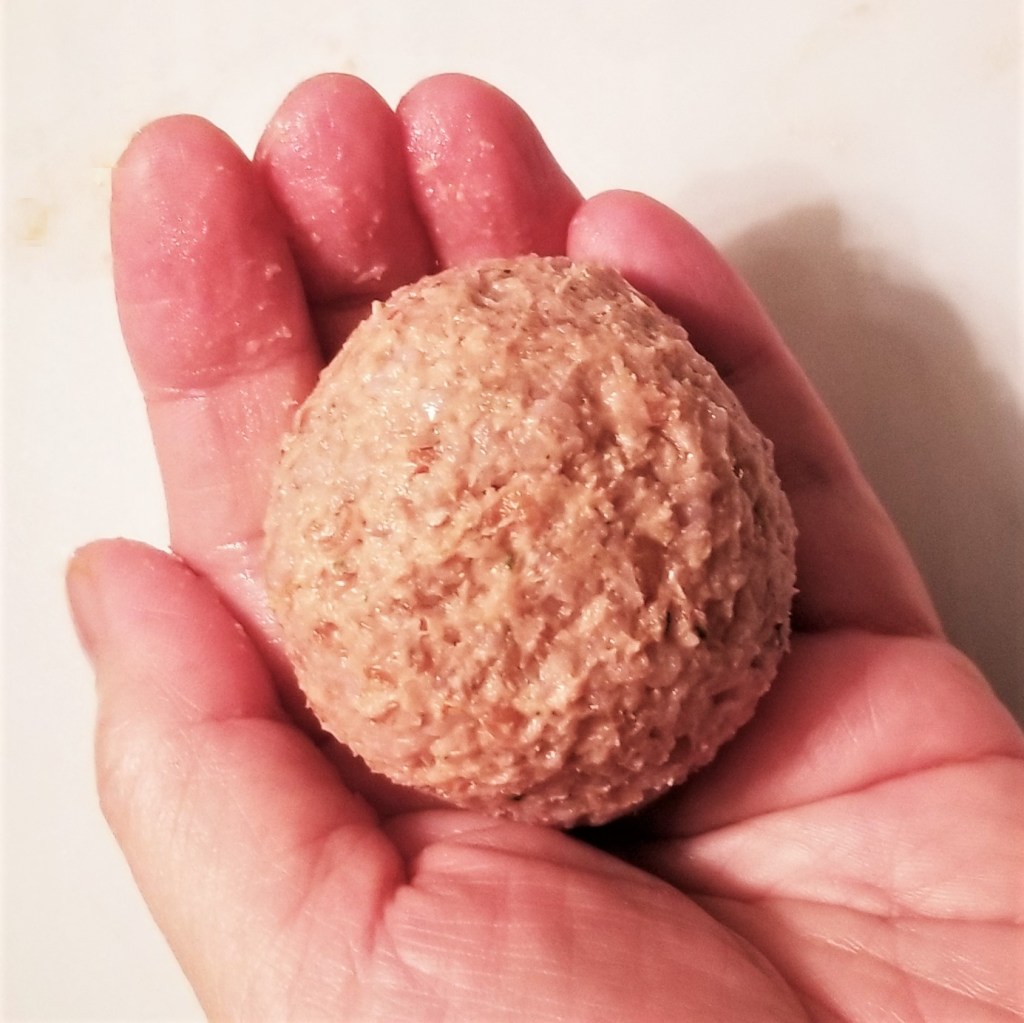

Continue pressing inside the edge, to form a bowl with the paste (photo below, left). Place a block of cheese in the bowl (photo below, centre), then press the edge of the bowl to close, and rotate the patty to form an oval with a pointy end (photo below, right):

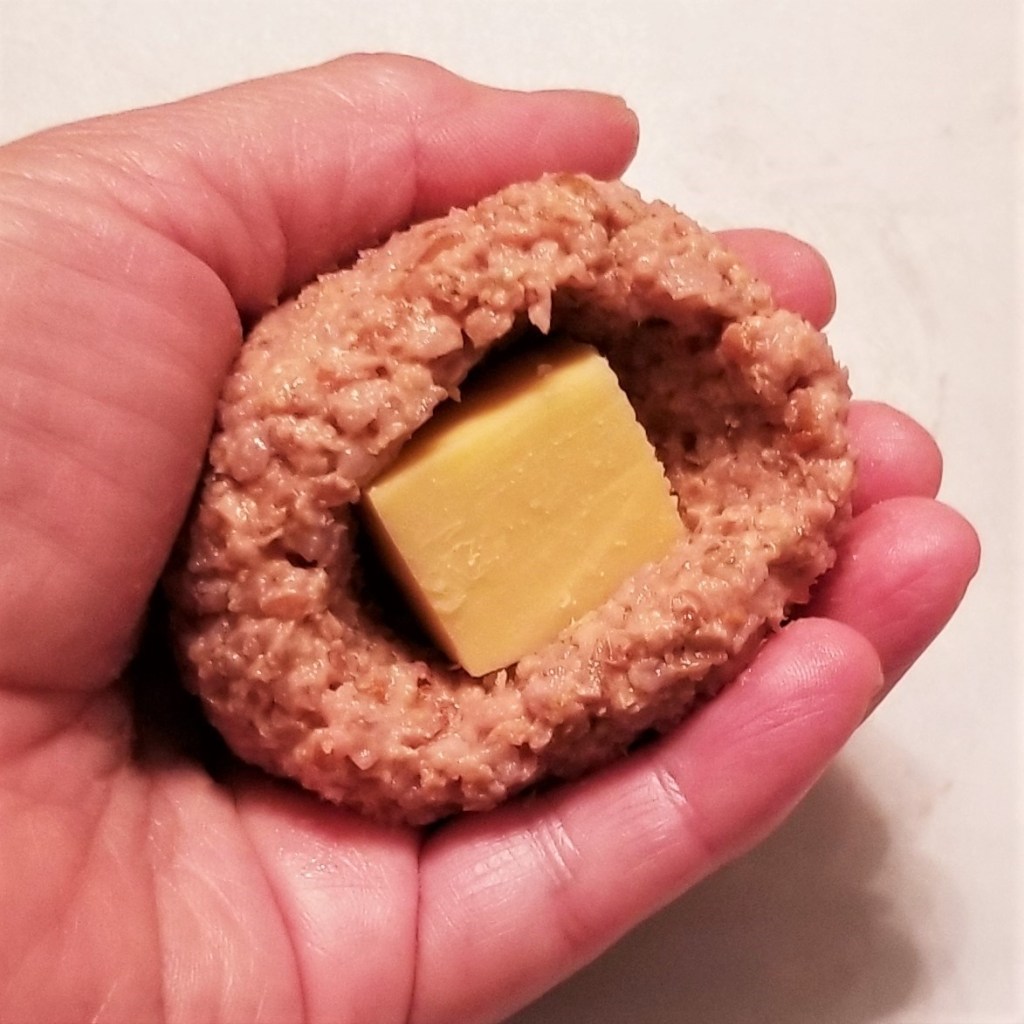

Turn the patty around and make the other end pointy. Repeat with the rest of the paste (makes 18 patties):

In a pot, pour enough oil for a depth enough to cover the patties; warm up over high heat until it starts to ripple (around 375ºF-190ºC). Add patties in batches, careful not crowd the pot; the oil should start bubbling (photo below, left). Flip the patties for an even browning, and remove once golden and crispy (photo below, right):
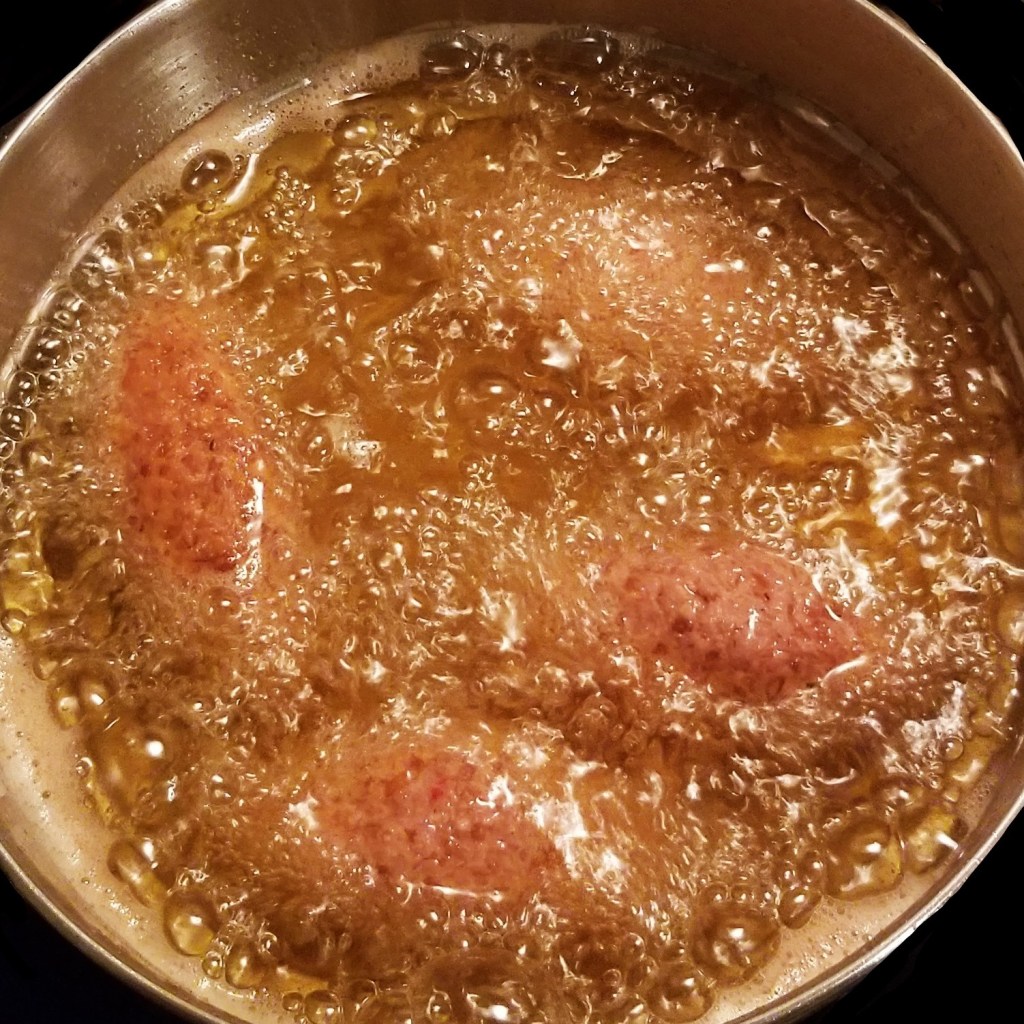
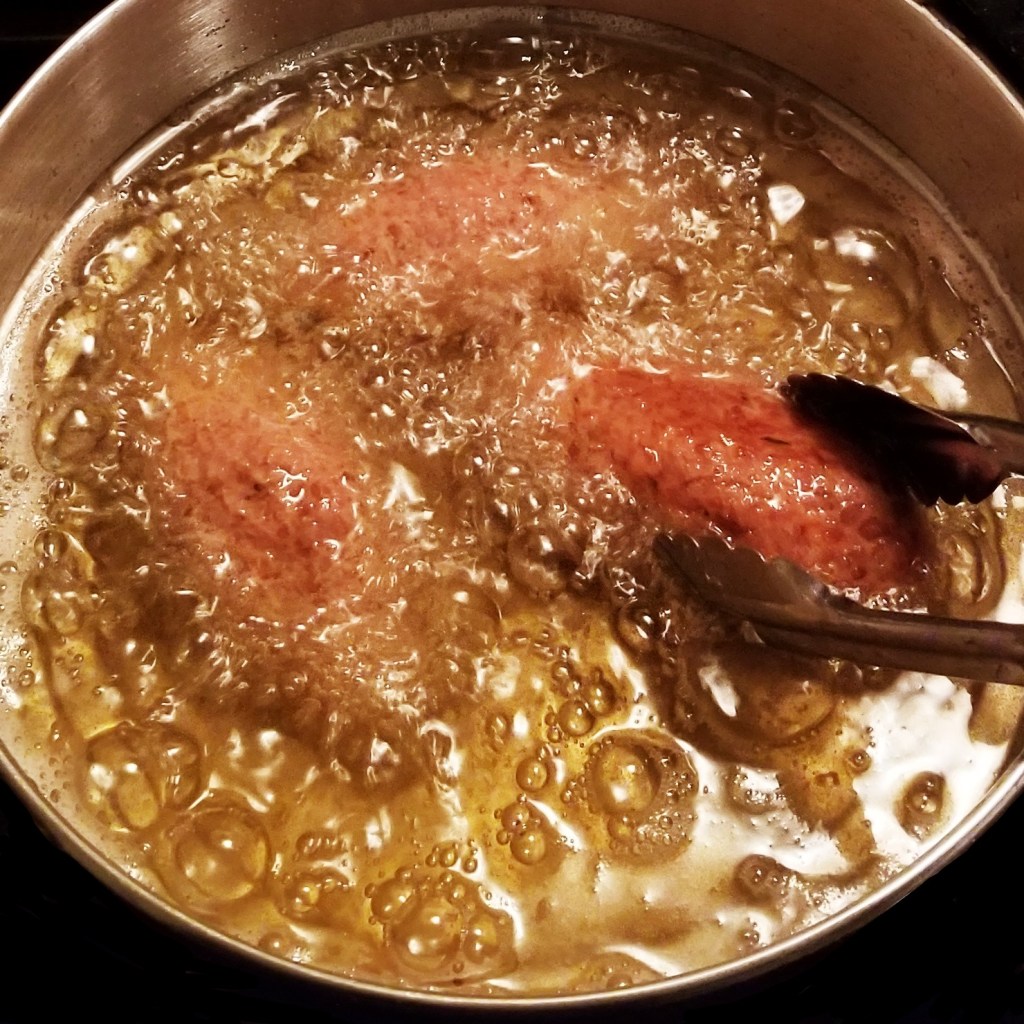
Transfer to paper towels to remove excess oil:

Continue frying patties in batches.
Serve hot with a side of topping:
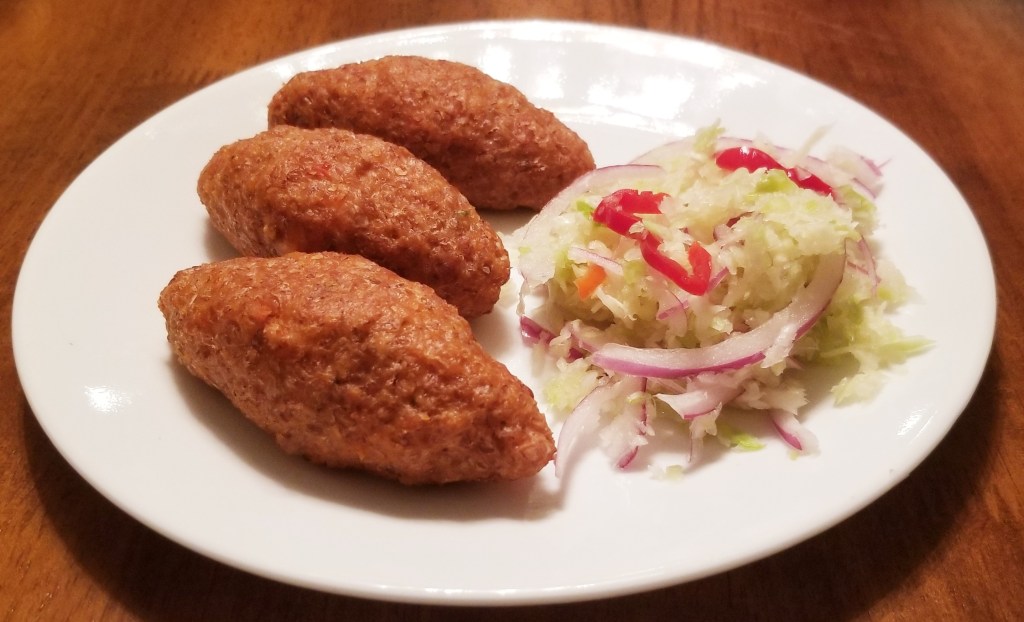
The traditional way in the Yucatan peninsula is to open the patty lengthwise (notice the delicious melted cheese in the middle, photo below, left), then filling with the cabbage preparation (photo below, right):
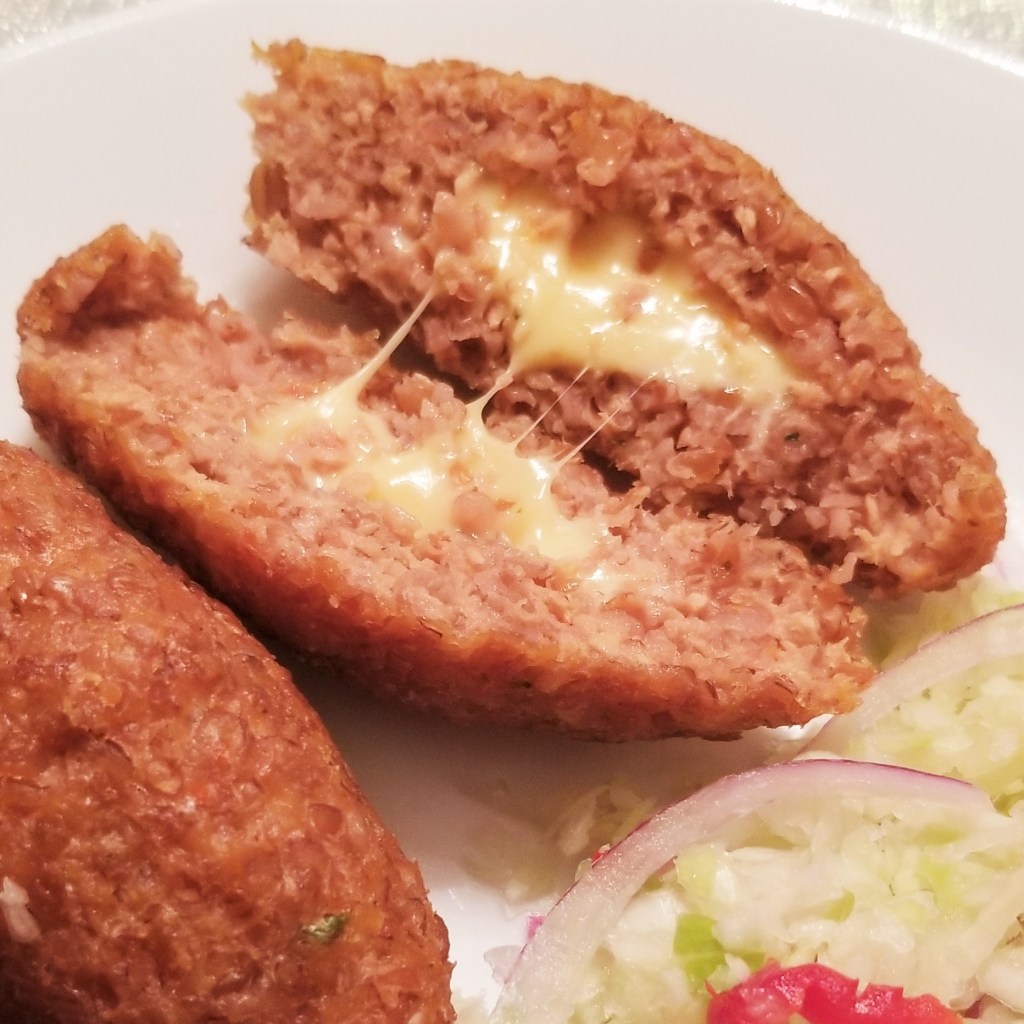
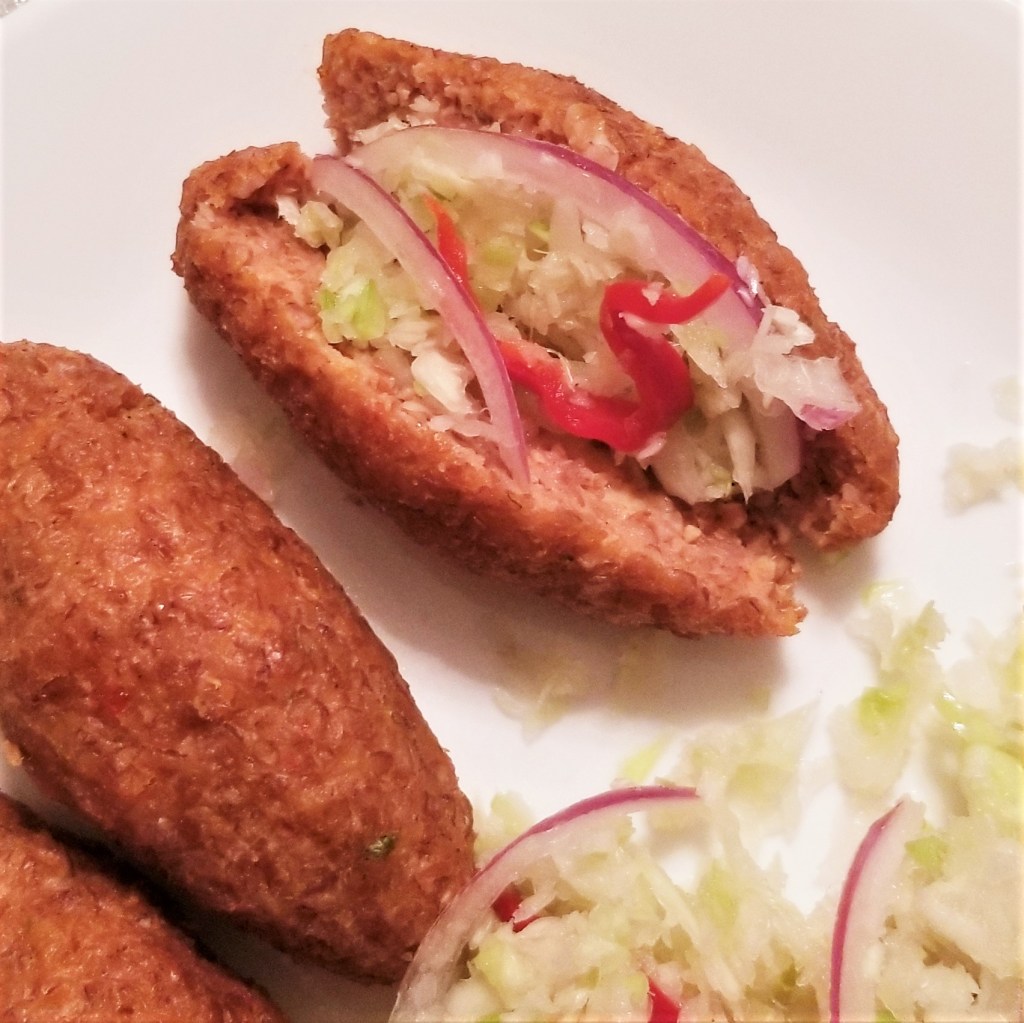
Kibis are often sold as a street food, sometimes made solid, without a filling, and prepared after frying, with a variety of toppings and salsas.
For your convenience, click on the highlighted text below for products available on Amazon™. DISCLAIMER: Any reviews included in this post are my own, for items I have purchased, not provided by any company; as an Amazon Associates Program affiliate, I might receive a commission for any purchases originated from the links below, at no extra cost to you. Thank you to readers who have bought other products starting with a click from my links!
I am sharing my recipe at What’s for Dinner? Sunday Link-Up #403 with Helen @ The Lazy Gastronome.
I am bringing my recipe to Full Plate Thursday #625 with Miz Helen @ Miz Helen’s Country Cottage.
I am sharing my post at Thursday Favourite Things #576, with Bev @ Eclectic Red Barn, Pam @ An Artful Mom, Katherine @ Katherine’s Corner, Amber @ Follow the Yellow Brick Home, Theresa @ Shoestring Elegance and Linda @ Crafts a la Mode.
I am joining Fiesta Friday #469 with Angie @ Fiesta Friday.

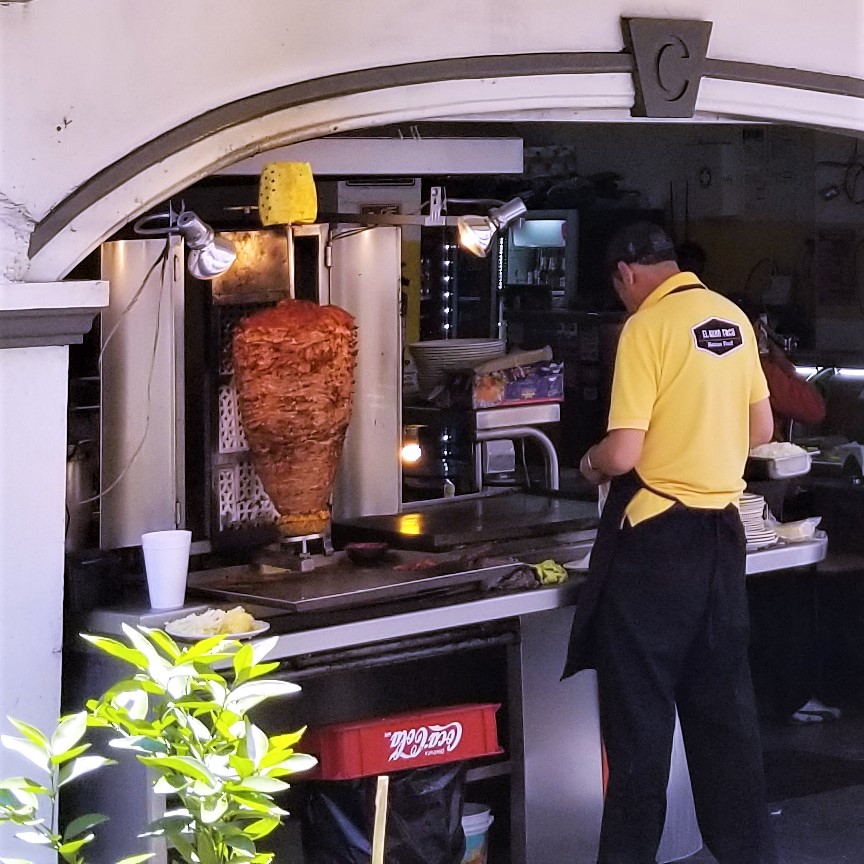

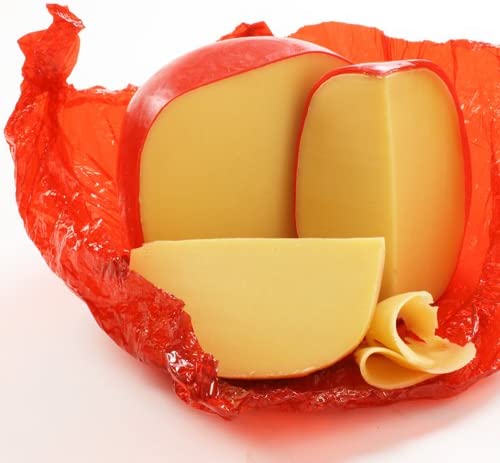
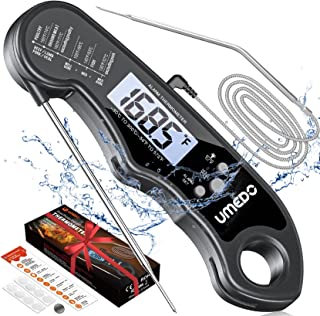








I’m a sucker for cheese-stuffed meatballs, so this is highly appealing to me! I’m saving this for sure!
LikeLiked by 1 person
Hope you like it, Angie!
LikeLike